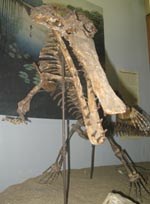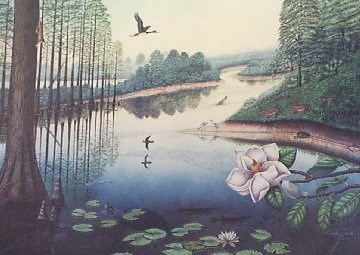
NPS Photo Note: Collecting fossils, petrified wood, rocks, or any other materials in Theodore Roosevelt National Park is prohibited by law. If you have ever stood in the badlands on a hot, dry summer day or a freezing, blustery winter day, a warm, wet, and humid swamp might be the most opposite type of climate and environment you could imagine. Despite its stark contrast with today, fossil evidence in Theodore Roosevelt National Park strongly suggests that a swampy environment is exactly what used to be here in today's badlands. The fossil record shows that in the Paleocene Epoch, just after the time of the dinosaurs, this area was a vast swamp teeming with turtles, crocodilians, and bald cypress trees. A three-year cooperative paleontological survey conducted in Theodore Roosevelt National Park by the North Dakota Geological Survey shed light on this part of North Dakota's geologic history. The fossilized remains of a crocodile-like reptile named Champsosaurus were excavated from a hillside in the South Unit in October 1995 by Dr. John Hoganson, paleontologist with the North Dakota Geological Survey, and his assistant, Jonathan Campbell. The ancient reptile once inhabited the fresh waters in what is now western North Dakota about 55 million years ago during the Paleocene epoch. At that time, the climate was subtropical, similar to that of present day Florida. The long, narrow snout and large powerful back legs would have enabled the Champsosaurus to feed on fish, snails, mollusks and turtles. Paleontologists believe that this ten-foot-long predator spent much of its time submerged in water waiting for prey, much like modern crocodiles. Champsosaurus could lunge from the bottom using its powerful back legs. A turtle shell with bite marks also found during this survey provides a vignette of life from this era. 
NPS During the paleontological inventory, more than two hundred fossil sites were identified and mapped from the rock layers known as the Sentinel Butte and Bullion Creek formations. The sites contained two other partial Champsosaur skeletons plus numerous freshwater mollusk remains, turtles (snapping and soft-shelled), parts of crocodiles and alligators, and plant fossils. The most common fossil found was petrified wood, including large tree stumps measuring seven to eight feet in diameter. It is believed that most of these trees were conifers, such as bald cypress and sequoia. The paleontological investigation enhanced our view of the park's geologic story. By identifying what creatures and plants existed here, one can get an impression of what life was like millions of years ago. With a clearer picture of the past, we gain a better perspective on this continuously changing environment. Why did the swamp disappear? Why is the landscape so rugged today? Read more about Geology of Theodore Roosevelt National Park. |
Last updated: May 4, 2015
